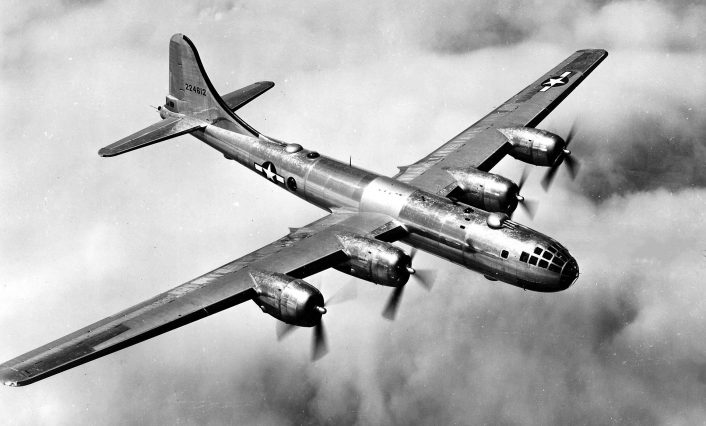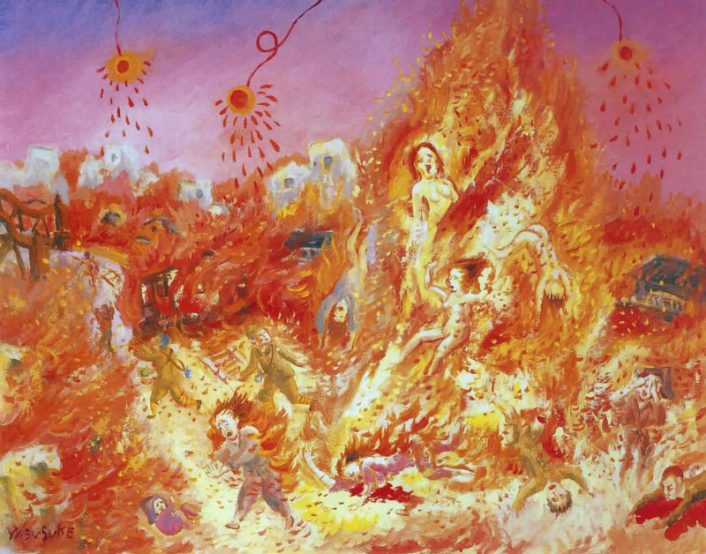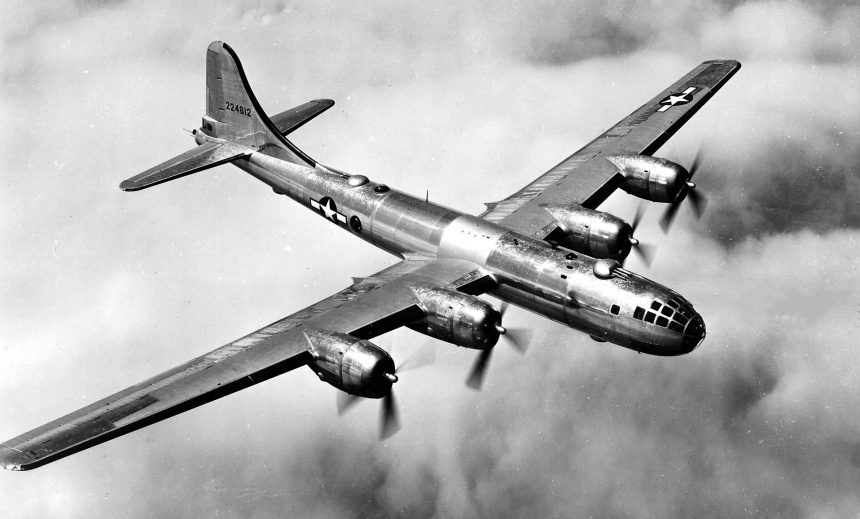Worse than the Nuclear Strikes on Hiroshima and Nagasaki, The Tokyo Fire Raid.
01:00 Hrs Local, Tokyo, Japan. March 9-10, 1945.
All of Tokyo is a funeral pyre.
Burning at over 1,100° Fahrenheit, rising flames create their own hurricane vacuum that inhales everything combustible to fuel the growing, miles-wide conflagration.
Fluttering to the ground in a wobbly topple incendiary bomblets continue to rain down from the night sky. These are not normal aerial bombs. The tiny bomblets are soft blobs of gooey, formless terror. They are E-46 chemical incendiary bombs or “fire bombs”.
The E-46s, one type of several incendiaries used in the raid, are dropped a mile above the city. They fall inside what looks like a conventional bomb casing built in Mays Landing, New Jersey. The nine retainer straps on the outside of the bomb break in unison, allowing the cluster bomb canister to open. They dispense a blizzard of 47 smaller, soft cheesecloth bags. The bags continue to tumble to earth. There is no concussive explosion or shockwave. No shattering glass. They quietly plop onto thatched rooftops and wooden buildings and begin to burn. And burn.
It is a strange, slow-motion attack. There are few thundering explosions. The air raid siren rises in volume through the night air. Then the low rumble of aircraft in the darkness overhead, the quiet pop and smack of incendiary packages bursting open and landing on rooftops as the first bomblets hit. A rising chorus of panicked screams follows as the fires begin to spread. The small fire from one bomblet quickly connects to another, then another, and then more. Soon the fires consume a city block, then the blocks of fire connect. More bags of fire land. The growing fire monster needs air to survive, and it begins a massive, city-wide yawn for oxygen to fuel its building inferno. Wind speeds pick up, pulling paper, cloth, even people into the building fire-hurricane.
Hell has come to earth.
Overhead a procession of 300 of the world’s largest strategic bomber, the Boeing B-29 Superfortress, rains flaming death with no quarter. This is Operation Meetinghouse. It remains the single deadliest air raid in human history, with a higher attributed death toll than either the Hiroshima or Nagasaki nuclear strikes or the fire raids on Dresden, Germany and the strategic bombing of German cities like Berlin.

The number of Japanese deaths in the Operation Meetinghouse air raid on the night of March 9-10, 1945 is disputed. The morbid accounting estimates a “low” of “88,000” (U.S. Strategic Bombing Survey, 1945) to a high of 200,000 deaths- a fifth of a million- by Elise K. Tipton, professor of Japanese studies at the University of Sydney, Australia. Over 1 million people are homeless. More will die of burns, disease and malnutrition in the coming days and weeks as every relief effort is not just stretched to the breaking point, it is shattered many times beyond it.
The stage for this human catastrophe was set years earlier, beginning with the Japanese attack on Pearl Harbor in 1941. But the factors that converged to enable the severity of Operation Meetinghouse took years to build, like a stack of petroleum soaked rags piling up in a corner until one day…
Japan was geographically isolated. Its conquest of the Pacific region was brutal beyond measure. Prisoners of the Japanese were often tortured, malnourished and diseased. There was little humanitarian treatment of prisoners. Many island populations were forced into slavery by the occupying Japanese. During one forced-march of U.S. and Philippine prisoners from Saysain Point and Mariveles, Bataan through almost 70 miles of jungle trail to a train station at Camp O’Donnell on April 9, 1942, as many as 18,650 prisoners died, including an estimated 600 Americans. The atrocity became known as the Bataan Death March. It followed closely on the surprise attack at Pearl Harbor a few months earlier.
The aggression between the Japanese and Allied forces was easily stoked by fears of an invasion in the United States. Barrage balloons flew over west coast U.S. cities. Fears of Japanese submarines landing saboteurs on the California beaches ran rampant. Following the Pearl Harbor attacks the Japanese stoked American fear by using crude balloon bombs released from submarines in an ineffective attempt to start forest fires in the American west. Japanese-Americans were confined to internment camps for “security” but were treated humanely compared to allied prisoners of the Japanese.
Both sides leveraged the racial differences between the Japanese and the Anglo-Americans to reinforce the notion that the other side was not human, but monsters who must be destroyed. Both populations bought into the narrative that this was a titanic battle for survival, and that the loser would be annihilated. In modern terms the war was portrayed as a kind of zombie-apocalypse. Propaganda portrayed the “Japs” as miniature, soulless yellow rodents with buck teeth and babies impaled on their bayonets. The Japanese painted the Americans as pale, marauding giants bent on murder, global domination, greed and conquest attempting to drive the Japanese to extinction.
In the months and years preceding Operation Meetinghouse the Pacific island-hopping campaign by the United States gathered momentum with the invasions of Rabaul, Guadalcanal and the Solomon Islands, advancing across the Pacific toward Japan.

But the distances between the islands were vast, making logistics difficult and creating a constant fury of running sea battles. The U.S. was making progress though. As the succession of invasions got closer to the Japanese home islands the fighting took on an even more maniacal brutality. In February, 1945, the U.S. invaded the island of Iwo Jima, the first landing on Japanese home territory. The fighting was horrific. Over 6,000 U.S. Marines, soldiers and sailors died while Japanese casualties were above 20,000. Iwo Jima was only 9 square miles. The Japanese and American forces traded nearly 3,000 lives per square mile on the barren island.
If the ratio of 3,000 lives lost for every one square mile of territory regained were applied to all of the Japanese islands covering 145,932 square miles the body count could rise to… 437,796,000 deaths, an impossible number six times greater than Japan’s total population. The improbable equation suggested Japan faced annihilation if invaded.
During strategic planning meetings in the U.S. estimates of the number of Allied casualties from an invasion of the Japanese home islands mentioned numbers that exceeded one million Americans. Japanese casualties would be much higher. Japan’s total population recorded in late 1945 was 71,998,104. In Russia’s defense of its homeland from invasion by the Germans they had somehow endured a staggering 26.6 million dead according to a 1993 study by the Russian Academy of Sciences, the greatest loss of human life by any country, in any war. It was reasonable to suggest Japan may lose well over 10 million people if the U.S. attempted an invasion of the main Japanese islands prior to forcing a surrender.
In the brutal calculus of global war there had to be a discounted solution to the horrifying equation.
Unbeknownst to nearly every person in the U.S. government and military, there was a small group of women and men working on a war-ending weapon in the remote desert of the southwestern United States, but that secret weapon, a bomb that released the energy of a splitting atom, was months away and still not a sure thing.
In the interim the U.S. felt it had only one option; massive fire-bombing of Japanese cities to destroy their war manufacturing and demoralize their population, forcing capitulation. It was late February, 1945.
The March 9-10 Operation Meetinghouse fire bombing centered on Japanese defense infrastructure. The Japanese had dispersed a significant amount of defense-related manufacturing to cottage industries in the outlying areas of Tokyo and other cities. Attempting to destroy each one with precision high-altitude bombing was impossible.
The Americans had a new super-weapon capable of striking Japan. It was a gigantic, gleaming silver bomber bigger than anything seen before. The huge plane was sleek and aerodynamic, with long, narrow wings and four massive engines prone to catching fire. It’s long, cylindrical fuselage was pressurized for high-altitude flight without supplemental oxygen and the crew compartments were heated. Even its defensive fire-control system was remote-controlled. The forward gun turret was fitted with four .50 caliber machine guns, twice the number on the top turret of the older B-17. Unlike the B-17 bomber crews, crews of the new mega-bomber did not have to wear heavy, electrically-heated flight suits and rely on oxygen to stay alive at altitude. These bomber crews fought in tropical utility shirt-sleeves.
The new plane was the Boeing B-29 Superfortress. My father was a draftsman and engineer for Boeing Aircraft in Seattle, Washington at “Plant 2” near the Duwamish River then. He worked on the top-secret development of the B-29. One of his assignments was to help draw plans for a pressurized crew tunnel through the bomb bay compartment from the front of the aircraft to the rear. He was sworn to secrecy during the aircraft’s development. Not even my mother knew what he was working on. Another project was to prepare drawings of the remotely controlled defensive gun control system.

The B-29 Superfortress was designed for high altitude strategic attacks. But the early high altitude airstrikes on Japan by B-29s were largely ineffective. The conventional explosive bombs did little damage on a large enough scale. Bomber crews were also wrestling with a new weather phenomenon encountered by the high-flying B-29. They discovered a consistent, ultra-fast wind aloft that ruined bombing accuracy called the “jet stream”.
In January, 1945, the commander of strategic air operations against the Japanese home islands was Major General Curtis LeMay. A somewhat controversial figure, LeMay was a pragmatist when it came to achieving military victory. It was simply a matter of lethal arithmetic. LeMay ordered the B-29s to begin bombing at night from low altitude instead of during the day. To improve aircraft performance and bomb payload, he ordered all of their defensive machine guns and their gunners removed.
LeMay’s Superfortresses would attack Tokyo on March 9-10 under the cover of darkness from low altitude, showering targets with fire bombs. Pinpoint accuracy was unnecessary. The first wave of bombers would drop their weapons to form a gigantic, flaming “X” to mark the center of the target. The rest of the Superfortresses would simply drop theirs as close as they could. The fires would do the rest.

It was difficult to keep the B-29s flying. Their four huge Wright R-3350 Duplex-Cyclone radial engines, the largest ever, were prone to catching fire. Maintenance was constant to prevent engine fires. When the heavily loaded bombers strained to take off, heaving massive bomb and fuel loads into the air, crashes were common.
Some aircraft were to launch from Tinian and Saipan, others from Guam. There were two parallel 8,500 foot runways recently built on Guam specifically to support the B-29 strikes on Japan. From this field Superfortresses of the 421st Bombardment Squadron, 504th Bombardment Group, would take-off.
Author Robert F. Dorr wrote what may be the definitive account of the Tokyo fire raid in his book “Mission to Tokyo”. Dorr wrote that while nearly all of the air crews in the B-29s on the night of March 9, 1945 were experienced veterans, many of them felt they would not survive this mission.
Major General LeMay’s order for the Superfortresses to fly without their defensive guns was not well received by crews. Robert F. Dorr wrote that the commander of one B-29 named “Lady Annabelle”, Capt. Percy Usher Tucker said, “I’m not leaving guns behind”. Other crew members said, “I’m not sure what General LeMay is thinking.” While official historical records did not indicate it, some crews kept guns and gunners on their aircraft, not putting the gunners’ names on the crew manifests for the mission.
Prior to Operation Meetinghouse, no bombing raid this large had been flown this low. Low altitude bombing missions were prone to heavy losses, as proven by the infamous Ploesti oil field raids in Romania in 1943. At Ploesti, losses of the B-24 Liberator bombers were horrendous when they flew into a maelstrom of enemy flak and the rising smoke of burning oil tanks on the ground.
While numerous historical accounts all agree that once the B-29 crews were airborne they were all-business, on take-off it was different. Most of the crew except the pilots sat idly in the dark aircraft hoping against a catastrophic engine failure with a full fuel and bomb load. One starboard gunner, Cpl. John R. Dodd, had a white-knuckle grip on his rosary. His voice came over the intercom saying, “I can’t do this, I can’t do this. I can’t do this.”
Oddly, the B-29s did not fly in formation on the way to Japan, but in a long, single file procession stretched out over miles and hours.
Reports differ about the lights being on or off in Tokyo that night. Some aircrews interviewed by author Robert F. Dorr told him they saw lights in the streets below. Japanese survivors say the standard air raid prevention protocols were in place, but often ignored. There was a quarter moon over Tokyo the night of the strike, so most B-29s made easy work of the long navigation to Tokyo. They arrived over the target accurately within minutes of their assigned time on target.

The pilots handed control over to their bombardiers who steered the aircraft to the precise release points using the autopilot slaved to their Norden bomb sights. Then they dropped their bombs.
Just before 2:00 AM in Tokyo the air raid was ending. Rising heat from the conflagration below caused massive turbulence for the last waves of bombers as they arrived over Tokyo. The planes bucked wildly on columns of ascending hot air. The target below was alternately obscured by smoke or illuminated by waves of flame below. Accurate bombing was impossible. So, the planes simply dumped their lethal ordinance. Losses of B-29s over the target were moderate.
When it was over, Tokyo was destroyed.
Interviews with survivors of Operation Meetinghouse on both sides are eerie. They both say some of the same things. The day after the raid there was an oppressive silence. In Tokyo, charred survivors, many with clothes singed off their bodies, wandered listlessly back into the smoke and embers of Tokyo’s ruins to find anything they could salvage. There was little. Among B-29 bomber crews who returned from the raid there was fatigue, exhaustion and the onset of a new phenomenon that did not yet have a name, Post-Traumatic Stress Disorder. Neither side emerged from Operation Meetinghouse unchanged. Even the granite-faced General Curtis LeMay seemed sobered by the aftermath.
The B-29 crews fought with tenacity to reach their targets and strike it accurately. While the moral ramifications of the raid would be debated to this day, these crews did not have the luxury of reflection on their mission. Japan was a desperate and lethal adversary entering its death throes. There was no negotiation, no time or space for moderation.
From the altitude of the years elapsed since Operation Meetinghouse, aerial bombing has evolved tremendously. While “humane” is never a word to describe aerial bombing, airstrikes have become more precise and produce less “collateral damage”, the antiseptic term coined for civilian casualties. Operation Meetinghouse was also one more straw added to the camel’s back of Japan’s resistance that was final broken by the nuclear strikes at Hiroshima and Nagasaki later that year.
In retrospect Operation Meetinghouse is largely missing from popular U.S. history of WWII. Few people know it happened. U.S. history classes almost never mention it, even though it was the largest air strike in history. But remembering this cataclysmic, deadliest air strike is key to avoiding any similar repeat in the future.










